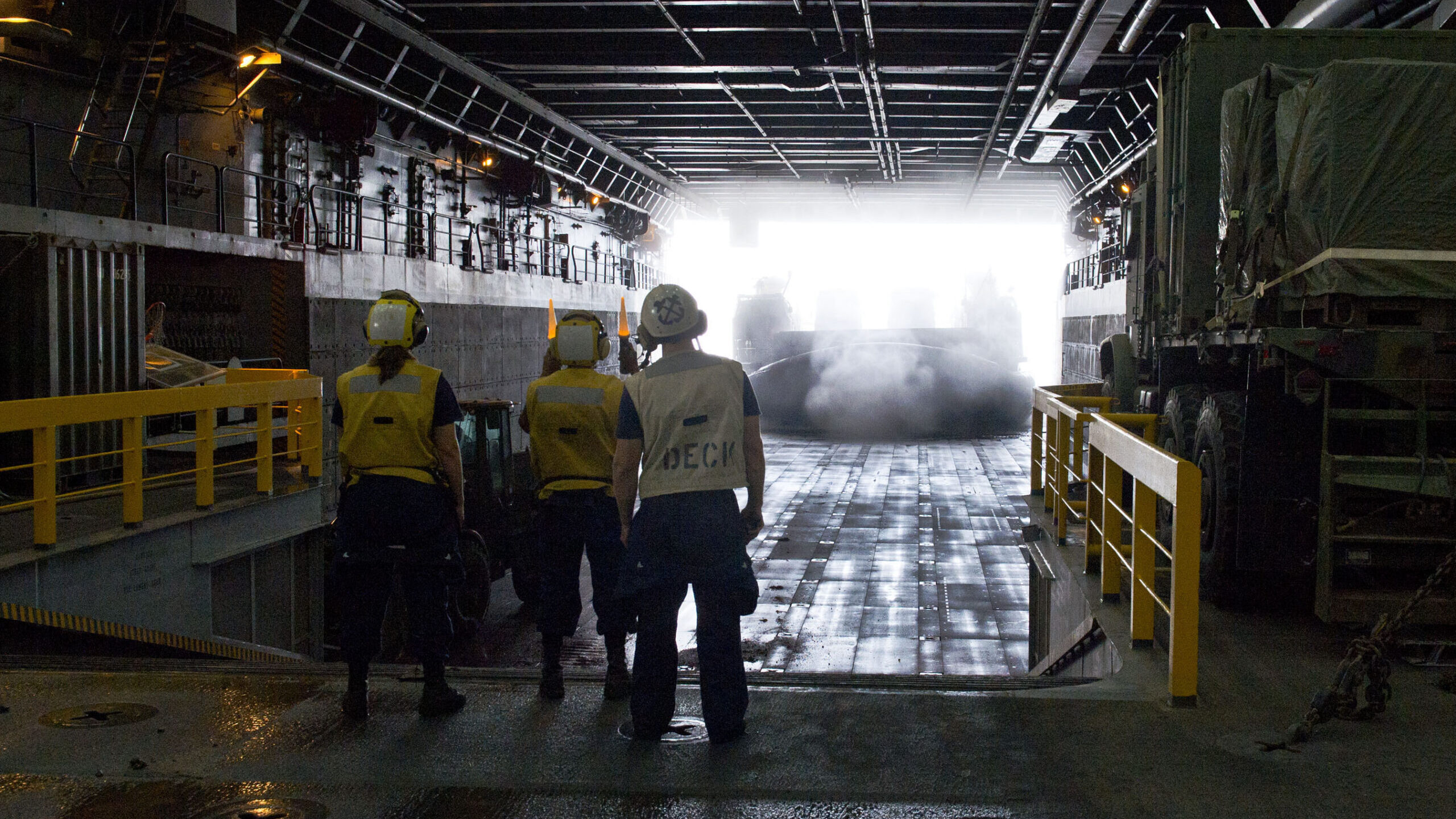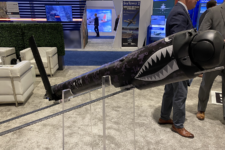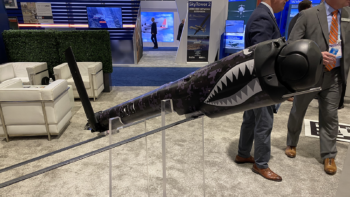
U.S. Navy boatswain’s mates direct a landing craft, air cushion into the well deck of the amphibious transport dock ship USS San Antonio (LPD 17) in the Gulf of Aden Aug. 5, 2013. (U.S. Navy photo by Mass Communication Specialist 3rd Class Lacordrick Wilson/Released)
One topic sure to come up frequently at this week’s Modern Day Marine conference in Washington, DC, is the decidedly controversial fate of the Marine Corps’s amphibious fleet and the public spat between lawmakers, the Biden administration and the services as to how many vessels are needed. In the op-ed below, CSIS’s Mark Cancian says Navy and Marines’ arguments need more clarity and some in Congress need to cool off.
An intra-governmental “war” has broken out between Congress and the Office of the Secretary of Defense (OSD) over how many large amphibious ships the Navy must have.
The Pentagon’s fiscal 2024 budget request “paused” construction of large amphibs. Congress disagrees, having long supported a large amphibious fleet. To show its annoyance at the Pentagon’s perceived recalcitrance, the House Armed Services Committee (HASC) has proposed abolishing the Pentagon office that recommended the “pause.” It is a clear statement about how strongly the committee feels, but, as a matter of public policy and constitutional responsibilities, the action is badly misplaced.
The Senate Armed Services Committee (SASC) has not supported abolishing the offending office but has thrown its considerable weight behind the higher number of large amphibious ships. However, the rift will not be repaired soon because the underlying disagreements remain unresolved.
RELATED: Senate authorizers poised to pressure Navy on amphib fleet, threaten financial penalties
The war began when a series of missteps by the Marine Corps undermined the justification for large amphibious ships. To overcome these missteps — and make things right with a skeptical Congress and OSD — it falls on the Navy and Marine Corps to develop stronger justifications for why they want 31 large amphibious ships and why OSD’s proposed smaller fleet is inadequate. Meanwhile, Congress should focus its attention on sharpening these arguments, rather than shooting the messenger.
How Did The ‘War’ Start?
This all began with the Marine Corps’ Force Design 2030. For many years, the Marine Corps’ stated requirement for amphibious ships was to lift the assault elements of two Marine brigades [PDF]. Each brigade required 17 ships, for a total of 34. Ten percent more were needed to account for ships in long-term maintenance and, hence, unavailable. That set a total requirement of 38. The Marine Corps grudgingly accepted a fiscally constrained goal of 34. That number also allowed the continuous peacetime deployment of three Marine Expeditionary Units for crisis response.
General Berger’s initial planning guidance as commandant ended that long-time rationale. It argued that large amphibious ships were too vulnerable and too expensive: “We must continue to seek the affordable and plentiful at the expense of the exquisite and few.” In highlighted text, the guidance announced: “We will no longer use a ‘2.0 MEB requirement’ as the foundation for our arguments regarding amphibious shipbuilding. We will no longer reference the 38-ship requirement.”
That fit the new vision of small Marine units carried in a new design small amphibious ship (then called the light amphibious warship, now called the medium landing ship). These groups would operate inside the Chinese weapons engagement zone and strike at the Chinese fleet with long-range missiles.
The Office of the Secretary of Defense, specifically the Directorate of Cost Assessment and Program Evaluation, (CAPE) took notice. CAPE―the lineal successor to famed Secretary of Defense Robert McNamara’s systems analysis office―analyzes programs and operations. Based on the new amphibious concept, it made the logical recommendation: If large amphibious ships were too expensive and too vulnerable and the Marine Corps believed that the future lay in small amphibious ships, then the Pentagon should limit the building of large amphibious ships.
The Navy came to the same conclusion. The Navy’s FY 2023 shipbuilding plan showed a target of 24 to 28 large amphibious ships, which meant that, when previously funded amphibious ships were considered, no amphibious ships would be needed for several years. The president’s FY23 and FY24 budget proposals “paused” construction of amphibious ships.
After Marines Reverse Course, HASC Strikes Back
Congress objected. Earlier, the Marine Corps had changed its position, arguing that 31 large amphibious ships were needed. Likely the concern over losing a fundamental Marine capability, pressure from elements in Congress and industry, and criticism that the new vision was ignoring global responsibilities all pushed the Marine Corps to reaffirm this traditional commitment.
The 31-ship requirement now appears in all their congressional testimony and documentation. Congress added funds for more amphibious ships in the FY23 budget. The secretary of the Navy committed to meeting the 31-ship goal but was vague about how or when.
For most disagreements, that would be the end of it. The president proposes; Congress disposes. Congress could continue to overrule DoD on amphibious ships. But the HASC took the matter a step further. It argued that Congress had set a requirement for 31 amphibious ships and that the Pentagon was ignoring the law. In retaliation, the House Armed Services Committee abolishes CAPE (section 902) in the draft House National Defense Authorization Act (NDAA).
As a matter of public policy, that move is unwise to the point of being irresponsible. CAPE is one of the few sources of independent advice available to the secretary and deputy secretary. A further problem is that legislation would abolish CAPE’s cost analysis function. Congress gave that office statutory responsibilities for doing cost estimates after cost overruns in many acquisition programs produced demands for reform.
The effort is also misplaced as a constitutional matter. First, it’s the president’s budget, not CAPE’s. CAPE may have provided advice, but the secretary of the Navy, the secretary of defense, and the White House have all endorsed the pause in building large amphibious ships. Second, the HASC argues that CAPE is not following statutory requirements. However, the president can propose whatever he wants under his powers in the Constitution: “He shall recommend to [the Congress’s] consideration such measures as he shall judge necessary and expedient.” (Article 2, Section 3).
The SASC And HAC-D Weigh In
The SASC was similarly supportive of amphibious ships in its recently released summary of the NDAA. Thus, it directs the Navy to produce a 30-year shipbuilding plan “that maintains 31 amphibious ships” with 24 available at any one time. It fully funds the next large amphibious ship in FY 2024 (LPD-33). Unlike the HASC, however, it strongly supports CAPE: “[The committee] expresses the sense of the Senate that the Office of Cost Assessment and Program Evaluation (CAPE) is vital to U.S. defense acquisition and requires new responsibilities for CAPE to improve the methods and effectiveness of its analyses.” The bill reportedly recommends unspecified “tweaks” to improve reporting and transparency.
The House Appropriations Committee-Defense did not provide money for an LPD in its draft FY 2024 appropriations bill, arguing that it was in advance of need since an LPD had been funded in FY 2023 and the usual spacing is two years. The committee did provide additional funds, $1.8 billion, for the LHA authorized in FY 2023.
The Continuing Weak Justification For Large Amphibious Ships
The controversy would die down if the Marine Corps offered a strong wartime rationale for 31 large amphibious ships. However, it continues its wartime emphasis on small units under FD 2030. The latest FD 2030 update does cite the need for 31 large amphibious ships but is vague about why, saying it’s: “[to] coordinate their actions directly with stand-in forces to control maritime terrain.” The Marine Corps has provided a calculation for their goal of 35 Landing ships Medium (nine for each of the three Marine Littoral Regiments and eight more for maintenance and other unavailability). Yet, there is no proposed calculation for arriving at 31 amphibious ships as there had been for the earlier amphibious ship goal of 34.
Some Marine officials have argued that 31 are needed for peacetime presence and crisis response. Indeed, General Berger’s FY 2024 congressional posture statement relies heavily on this rationale. Presence and crisis response have been a long-time Marine Corps missions, and the mathematics work out―deployments at historical levels require large amphibious ships numbering in the low 30s. However, the weakness of the argument is that the Marine Corps wants to build extremely capable and expensive platforms that it has already argued are vulnerable in wartime. If the main requirement is peacetime employment, then different and much cheaper platforms would suffice.
The Navy has completed an amphibious fleet requirements study that may provide answers to these questions. The Navy has provided the study to Congress, but it has not released the plan to the public.
Ironically, a group of retired generals who have bitterly opposed FD 2030 has provided the strongest defense of large amphibious ships. Among their many objections to FD 2030 is that the Marine Corps needs to focus on global responsibilities and combined arms rather than light forces focused on the Western Pacific. Thus, they argue that large amphibious ships have a wartime function and that small amphibious ships are unable to replace them, being too slow and vulnerable.
Looking Ahead: CAPE Survives, As Do Large Amphibious Ships
The final NDAA is unlikely to eliminate CAPE. The SASC has disagreed, and they are office is too useful to the secretary, has many supporters, and performs functions that Congress itself had directed.
Large amphibious ships will survive because Congress and, now, the Marine Corps want them. These ships have a long history of successful employment in peace and in war. Whether DOD has been sufficiently intimidated to include them in future budgets remains to be seen.
Despite congressional goals and declarations, the size of the amphibious fleet will depend on future DoD budgets. In the past few years, Congress added considerable funds to cover inflation and additional programs. Additional funds make it easier to buy amphibious ships that are not in the budget. However, if the deficit hawks prevail and the defense budget is capped long-term, as is possible under the 2023 current budget agreement, then something must give. This controversy is not over yet.
Mark Cancian, a member of the Breaking Defense Board of Contributors, is a retired Marine colonel now with the Center for Strategic and International Studies.






















